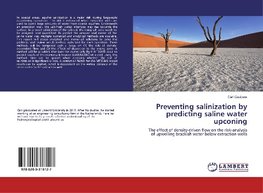
-
 Anglický jazyk
Anglický jazyk
Preventing salinization by predicting saline water upconing
Autor: Carl Geuljans
In coastal areas, aquifer salinization is a major risk during large-scale dewatering operations. This risk is enhanced when extraction wells are used to pump large amounts of water from coastal aquifers. Underneath an extraction well, the salt-fresh water... Viac o knihe
Na objednávku, dodanie 2-4 týždne
36.99 €
bežná cena: 41.10 €
O knihe
In coastal areas, aquifer salinization is a major risk during large-scale dewatering operations. This risk is enhanced when extraction wells are used to pump large amounts of water from coastal aquifers. Underneath an extraction well, the salt-fresh water interface may rise towards the surface. To prevent salinization of the sub-soil, the rising salt cone needs to be analyzed, and quantified. To predict the amount and extent of the saline water rise, multiple numerical and analytical methods are available. This report will assess analytical and numerical solutions to solve this problem, and review which method suits best for each operation. These methods will be compared with a focus on (1) the role of density-dependent flow and (2) the effects of dispersion to the mixing zone. A method will be provided that uses the numerically light MT3DMS code to predict results of the numerically heavier SEAWAT2000 v4 model. Using this method, time can be spared when assessing whether the risk of salinization is significant or not. A correction factor for the MT3DMS model results can be applied, which is dependent on the vertical distance of the saline water to the extraction well.
- Vydavateľstvo: LAP LAMBERT Academic Publishing
- Rok vydania: 2019
- Formát: Paperback
- Rozmer: 220 x 150 mm
- Jazyk: Anglický jazyk
- ISBN: 9786200316127



 Nemecký jazyk
Nemecký jazyk 
 Francúzsky jazyk
Francúzsky jazyk 







